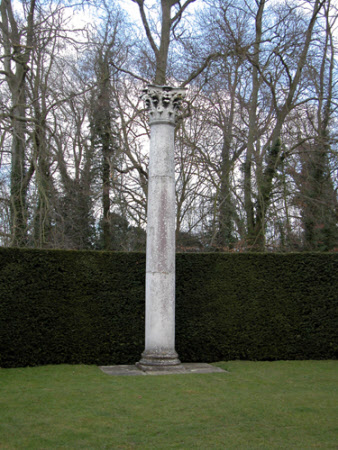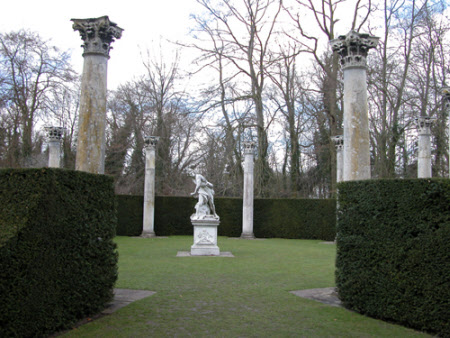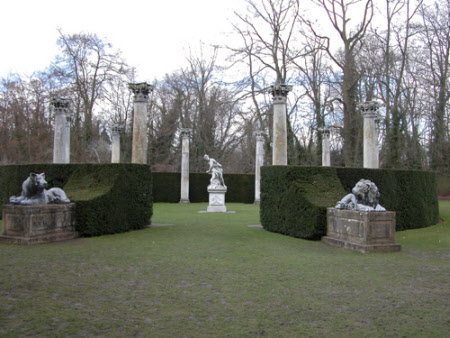Ten Corinthian Columns
British (English) School
Category
Art / Sculpture
Date
circa 1748 - 1752
Materials
Portland Stone
Measurements
20 ft (Height)
Place of origin
Great Britain
Order this imageCollection
Anglesey Abbey, Cambridgeshire
NT 516659
Summary
Portland stone, ten Corinthian Columns from Chesterfield House, London, British (English) School, c. 1748-52. A set of ten columns in the Corinthian order, with typically elaborate capitals carved with acanthus and scrolls. Removed from Chesterfield House, the Mayfair mansion of Philip Stanhope, 4th Earl of Chesterfield (1694–1773), built between 1747 and 1752 and demolished in 1937. Mounted on concrete and paving stone bases and installed in a circle on Temple Lawn in 1953; with lead covers on the capitals.
Full description
When Chesterfield House was pulled down before the Second World War its fabric, writes Roger White, was 'cannibalised for re-use elsewhere': a caryatid chimneypiece going to the Metropolitan Museum of Art, New York, for example, and a set of ten Corinthian columns to Anglesey Abbey (White 1984, p. 175). These presumably came from the west front colonnade, narrowed in 1870 by Charles Magniac, and depicted in an original watercolour from the Office of Works (now inv. no. 17/3/9, Soane office, Sir John Soane's Museum, London) and later in a photograph published in Country Life (Tipping 1922, p. 235). Chesterfield House was designed by Isaac Ware (1704-66), a protégé of Lord Burlington and architect at the Office of Works who, in 1738, published a definitive translation of Palladio's Quattro Libri illustrated with his own drawings. Ware was devoted to the application of the Palladian style to every part of a building and was scathing about the influence of the French rococo which his Francophile patron, the Earl of Chesterfield, favoured. This disparity of taste, epitomised by Ware in an oft-quoted passage from his 'Complete Body of Architecture', ultimately culminated in Ware's greatest commission, a masterpiece of English Palladianism and Rococo combined (Parker 1963, p. 203). Frustratingly little detail is provided by Ware on the craftsmen employed to furnish Chesterfield House. 'First artists in their several professions' are acknowledged which suggests English origin. Alice Rylance-Watson 2019
Provenance
Made for Philip Stanhope, 4th Earl of Chesterfield (1694–1773) for Chesterfield House, London; removed from Chesterfield House between 1870 and 1937; purchased by Urban Huttleston Rogers Broughton, 1st Lord Fairhaven (1896-1966) c. 1953; bequeathed to the National Trust by Lord Fairhaven with the house and the rest of the contents.
Makers and roles
British (English) School, mason
References
White 1984: Roger White, ‘Isaac Ware and Chesterfield House’, in Charles Hind (ed.), The Rococo in England. A Symposium, Victoria and Albert Museum, London 1984, pp. 175-92. Tipping 1922: H. Avray Tipping, 'Chesterfield House, Mayfair.- I. A Residence of Viscount Lascelles', Country Life, 25 February, 1922, pp. 235-42., p. 235. Ware, Isaac, A complete body of architecture., 1756 Parker 1963: James Parker '"Designed in the Most Elegant Manner, and Wrought in the Best Marbles": The Caryatid Chimneypiece from Chesterfield House', The Metropolitan Museum of Art Bulletin, New Series, vol. 21, no. 6 (February 1963), pp. 202-13. Roper 1964: Lanning Roper, The Gardens of Anglesey Abbey, Cambridgeshire. The Home of Lord Fairhaven, London 1964, pp. 53-4. Christie, Manson & Woods 1971: The National Trust, Anglesey Abbey, Cambridge. Inventory: Furniture, Textiles, Porcelain, Bronzes, Sculpture and Garden Ornaments’, 1971, p. 171.


